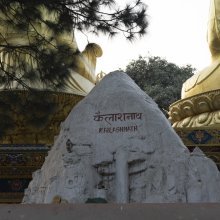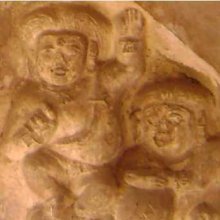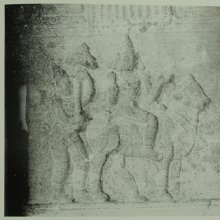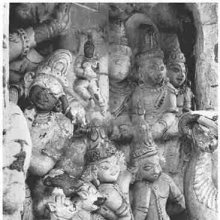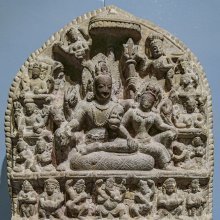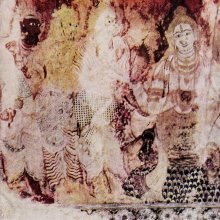Kailasa, Kailāsa, Kailāśa, Kailasha: 32 definitions
Introduction:
Kailasa means something in Buddhism, Pali, Hinduism, Sanskrit, Jainism, Prakrit, the history of ancient India, Marathi. If you want to know the exact meaning, history, etymology or English translation of this term then check out the descriptions on this page. Add your comment or reference to a book if you want to contribute to this summary article.
The Sanskrit term Kailāśa can be transliterated into English as Kailasa or Kailasha, using the IAST transliteration scheme (?).
Images (photo gallery)
(+6 more images available)
In Hinduism
Vastushastra (architecture)
Source: Wisdom Library: Vāstu-śāstra1) Kailāśa (कैलाश):—The Sanskrit name for one of the five Vimānas created by Brahmā, the great Creator, in the hoary past for gods. They were for travelling in the air, beautiful to look at, colossal in shape, made of gold and studded with gems. Kailāśa was to be used by Śiva, the trident-holder. Vimānas represent the ‘aerial chariots’ of the gods, but also refers to seven-storey palaces. It is described in the 11th-century Samarāṅgaṇasūtradhāra (49.3) by Bhojadeva. Accordingly, “Kailāśa may be globular in structure”. It is from the self-same five shapes of Vimānas that later on, Brahmā created the Prāsāda.
The Kailāśa type of Vimāna exhibits ten different temples:
- Valaya,
- Dundubhi,
- Prānta,
- Padma,
- Kānta,
- Caturmukha,
- Māṇḍuka,
- Kūrma,
- Tāligṛha,
- Ulūpika.
These are the names of 10 out of a total of 64 temples (prāsāda) mentioned in same chapter.
2) Kailāśa (कैलाश):—The name of a group of temple classifications, comprising 9 circular-shaped temple categories, according to the 8th-century Agnipurāṇa. The Kailāśa group is one of the five groups mentioned in the purāṇa, and represents the North-Indian classification of temples.
- Valaya,
- Dundubhi,
- Padma,
- Mahāpadma,
- Vardhanī,
- Uṣṇīṣa,
- śaṅkha,
- Kalaśa,
- Śrīvṛkṣa.
3) Kailāśa (कैलाश) refers to a type of temple (prāsāda) classified under the group named Sāndhāra, according to Samarāṅgaṇasūtradhāra chapter 56. The Sāndhāra group contains twenty-five out of a sixty-four total prāsādas (temples) classified under four groups in this chapter. The Samarāṅgaṇasūtradhāra is an 11th-century encyclopedia dealing with various topics from the Vāstuśāstra.
Kailāśa is found in another list in the Samarāṅgaṇasūtradhāra, chapter 60, where it is mentioned in a list of thirty-six Prāsādas (temples) having activities of the townsmen entailing Sādhārās.
Kailāśa is found in another list in the Samarāṅgaṇasūtradhāra, chapter 63, where it is listed in the group named Nāgara, containing 20 different prāsādas (temples/buildings).
Kailāśa is also listed in the Suprabhedāgama, which describes a list of 13 temple types. This list represents the earliest form of the classification of temples in the South Indian Vāstuśāstra literature.
Kailāśa is also listed in the Īśānaśivagurudevapaddhati which features a list of 52 temple types. This list represents the classification of temples in South-India.
Kailāśa is also listed in the Matsyapurāṇa which features a list of 20 temple types. This list represents a classification of temples in Nort-India.
3) Kailāsa (कैलास) refers to a variety of prāsāda (‘superstructure’, or, upper storey of any building), according to the Mayamata (5th-century guidebook on Dravidian architecture). It is part of the Dvitala (two-storey) group of prāsādas.
The Kailāsa variety has the following specifications and decorative motif components:
Number of talas (levels): 2;
Shape of grīva (neck) and śikhara (head): Square;
Number of śālas: 4 (with upapīṭhas);
Number of kūṭas: 4 (taller than the śālas);
Number of pañjaras: 8;
Number of alpanāsis: 48;
Kailāśa temple is an example of a monolithic temple (shrines carved from top to bottom out of one piece of
rock). The grandest of the monolithic temples is the famous Kailāśa temple at Ellora in the reign of the Rāṣṭrakūṭas in the 8th century.
Kailāsa (कैलास) refers to one of the hundred types of Temples (in ancient Indian architecture), according to the Viṣṇudharmottarapurāṇa, an ancient Sanskrit text which (being encyclopedic in nature) deals with a variety of cultural topics such as arts, architecture, music, grammar and astronomy.—It is quite difficult to say about a definite number of varieties of Hindu temples but in the Viṣṇudharmottarapurāṇa hundred varieties of temples have been enumerated. For example, Kailāsa. These temples are classified according to the particular shape, amount of storeys and other common elements, such as the number of pavilions, doors and roofs.

Vastushastra (वास्तुशास्त्र, vāstuśāstra) refers to the ancient Indian science (shastra) of architecture (vastu), dealing with topics such architecture, sculpture, town-building, fort building and various other constructions. Vastu also deals with the philosophy of the architectural relation with the cosmic universe.
Purana and Itihasa (epic history)
Source: Wisdom Library: Varāha-purāṇa1) Kailāsa (कैलास) is the name of a mountain situated at lake Mānasa and mount Gandhamādana, according to the Varāhapurāṇa chapter 75. The Gandhamādana mountain lies on the eastern side of mount Meru, which is one of the seven mountains located in Jambūdvīpa, ruled over by Āgnīdhra, a grandson of Svāyambhuva Manu.
2) Kailāsa (कैलास).—Name of a minor mountain (kṣudraparvata) situated in Bhārata, a region south of mount Meru, according to the Varāhapurāṇa chapter 85. In the settlements (janapada) along these mountains dwell Āryas and Mlecchas who drink water from the rivers flowing there. Meru is one of the seven mountains located in Jambūdvīpa, which is ruled over by Āgnīdhra, a grandson of Svāyambhuva Manu, who was created by Brahmā, who was in turn created by Nārāyaṇa, the unknowable all-pervasive primordial being.
Svāyambhuva Manu was created by Brahmā, who was in turn created by Nārāyaṇa, the unknowable all-pervasive primordial being.
Source: archive.org: Puranic Encyclopedia1) Kailāsa (कैलास).—(KAILĀSAKA). A serpent belonging to the Kaśyapa family. Mention is made about this serpent in Mahābhārata, Udyoga Parva, Chapter 103, Stanza 11. (See full article at Story of Kailāsa from the Puranic encyclopaedia by Vettam Mani)
2) Kailāsa (कैलास).—General information The mount Mahāmeru has an area of eighteen thousand nāzhikas (Indian mile of (1/4) Kośa) and a height of two thousand nāzhikas. On the eastern side of this mount there are two mountains called Jaṭhara and Devakūṭa. Pavamāna and Pāriyātra are the two mountains on the western side. On the south there are the two mountains of Kailāsa and Karavīra. The two mountains on the north are called Triśṛṅga and Makaragiri. It is stated in Mahābhārata, Vana Parva, Chapters 109 and 141 that the abodes of Śiva and Kubera are on the mount Kailāsa. Once, to please Śiva, Mahāviṣṇu performed penance on Kailāsa. (Mahābhārata Ādi Parva, Chapter 222, Stanzas 33 to 40). It is mentioned in Mahā Bhārata, Sabhā Parva, Chapter 3 that the mountain Maināka stands to the north of Kailāsa. Once Vyāsa went to Kailāsa. (Mahābhārata Sabhā Parva, Chapter 43, Stanza 17). In Vana Parva, Chapter 106, mention is made that the King Sagara, with his two queens, once went to Kailāsa for penance. It was on the Kailāsa that Bhagīratha performed penance to propitiate Śiva to bring down Gaṅgā. Kailāsa is hundred yojanas high. The devas come to this place daily and return. It is mentioned in Sabhā Parva, Chapter 141, that in the place where Kubera lives on Kailāsa there live a large number of Yakṣas (demi-gods), Rākṣasas (giants) Kinnaras (heavenly musicians), Garuḍas (hawks) Mātaṅgas (elephants) and Gandharvas (semi-gods). The lake of lotus of Kubera which was reached by Bhīmasena once, was in Kailāsa. In Vana Parva, it is mentioned that the Pāṇḍavas visited Kailāsa during their forest life. It could be understood from Mahābhārata, Anuśāsana Parva, Chapter 83 that Kāmadhenu performed penance on the Kailāsa, once.
Source: archive.org: Shiva Purana - English Translation1) Kailāsa (कैलास) or Kailāsasaṃhitā refers to one of the seven books (saṃhitās) of the Śiva-purāṇa, according to the Śivapurāṇa-māhātmya 1.30-34.—“[...] This work consists of twenty-four thousand verses divided into seven saṃhitās (compendiums) [viz., kailāsa-saṃhitā]. The three kinds of Devotion [(1) by meditation, (2) recital of prayer and (3) acts of worship and service] are fully explained in it. It must be listened to with great respect. [...] This divine Purāṇa of seven saṃhitās and called after Śiva stands on an equal footing with Brahman (i.e. Vedic Texts) and accords an achievement that is superior to everything else. He who reads the entire Śivapurāṇa without omitting any of the seven saṃhitās can be called a Jīvanmukta (a living liberated soul)”.
2) Kailāsa (कैलास) refers to the pure world where Rudra is stationed, as defined in the Śivapurāṇa 1.17. Accordingly, “[...] in the pure world of Kailāsa, Rudra, the annihilator of the living beings, is stationed. Beyond that are the fifty-six worlds ending with Ahiṃsā region”.
3) Kailāsa (कैलास) or Kailāsanagara is the residence of Śiva, according to the Śivapurāṇa 2.1.15:—“[...] the five-faced lord Śiva created for His residence the beautiful city (nagara) of Kailāsa that shone above all. O celestial sage, Kailāsa and Vaikuṇṭha will never be destroyed even if the whole cosmic egg is destroyed”.
Kailāsa is located on the central peak of Hemakūta which is one of the loftiest peaks to the North of the Mānasa lake.
Kailāsa is described as the “auspicious excellent mountainous abode of Śiva”, according to the Śivapurāṇa 2.2.40.—
Source: Cologne Digital Sanskrit Dictionaries: The Purana Index“Kailāsa was a favourite abode of the lord where Kinnaras, Apsaras, Siddhas and other divine beings stayed. It was very high. Kailāsa was brilliant with many peaks full of precious gems all round.
Kailāsa was of variegated colour due to diverse minerals. It contained different trees and creepers. Many kinds of deer roamed and many kinds of birds hovered there. The celestial and Siddha damsels sported about in different springs and pools along with their husbands and lovers. It contained many caves and ridges. It shone with various kinds of trees and had a silver lustre.
Kailāsa was infested with big animals, tigers and others who were free from cruelty. It was of divine nature endowed with shining brilliance. It inspired great surprise and wonder. The river Gaṅgā originating from the holy abode of Satī, sanctifying everything flowed there and so the place was very clean. On seeing this mountain named Kailāsa, a great favourite of Śiva, Viṣṇu and other devas were surprised along with the excellent sages”.
1a) Kailāsa (कैलास).—(śikhara)—the abode of Śiva seated on a baniyan tree and of Yakṣas, full of different plants, trees and flowers, birds and beasts. Here are the city of Alakā, and the forest Saugandhika.1 It is located on the south of Meru,2 on the Himalayan slopes; the residence of Kubera. Described.3 North of Atri's hermitage.4
- 1) Bhāgavata-purāṇa IV. 5. 26; VI. 8. 33; IX. 4. 55; X. 10. 2; 55 [1]; Matsya-purāṇa 54. 3; 62. 2; Vāyu-purāṇa 30. 85; 35. 9; 36. 24; 38. 33; 41. 1; 42. 32; 47. 1; 50. 48; 54. 35-6; 101. 303.
- 2) Bhāgavata-purāṇa V. 16. 27; Viṣṇu-purāṇa II. 2. 42.
- 3) Brahmāṇḍa-purāṇa II. 18. 1-4; 20. 50, 25. 24-40; III. 13. 36; 22. 56; 25. 9; 41. 18; IV. 9. 30; 10. 27.
- 4) Matsya-purāṇa 121. 2-5; 163. 85; 183. 1.
1b) A form of temple with 9 storeys and a toraṇa with 40 hastas.*
- * Matsya-purāṇa 269. 28-31, 47.

The Purana (पुराण, purāṇas) refers to Sanskrit literature preserving ancient India’s vast cultural history, including historical legends, religious ceremonies, various arts and sciences. The eighteen mahapuranas total over 400,000 shlokas (metrical couplets) and date to at least several centuries BCE.
Shaivism (Shaiva philosophy)
Source: Wisdom Library: ŚaivismKailāsa (कैलास) is a Sanskrit word referring to two of the sixty-eight places hosting a svāyambhuvaliṅga, one of the most sacred of liṅgas according to the Śaivāgamas. The presiding deity residing over the liṅga in the first place named Kailāsa, is Tripurāntaka, and the deity presiding over the second place is named Gaṇadhipa. The list of sixty-eight svāyambhuvaliṅgas is found in the commentary of the Jirṇoddhāra-daśaka by Nigamajñānadeva. The word liṅga refers to a symbol used in the worship of Śiva and is used thoughout Śaiva literature, such as the sacred Āgamas.

Shaiva (शैव, śaiva) or Shaivism (śaivism) represents a tradition of Hinduism worshiping Shiva as the supreme being. Closely related to Shaktism, Shaiva literature includes a range of scriptures, including Tantras, while the root of this tradition may be traced back to the ancient Vedas.
Kavya (poetry)
Source: Wisdom Library: KathāsaritsāgaraKailāsa (कैलास) is Sanskrit name of a mountain-peak, located with the Himavat (moutain range). It is the dwelling place of Maheśvara (the beloved of Pāravtī) who is the “chief of things animate and inanimate”, according to the Kathāsaritsāgara, chapter 1, written by Somadeva in the 11th-century. Accordingly, “...the northernmost summit thereof (of Himavat) is a great peak named Kailāsa, which towers many thousand yojanas in the air”; and further, “there dwells Maheśvara the beloved of Pārvatī, the chief of things animate and inanimate, attended upon by Gaṇas, Vidyādharas and Siddhas.”
Kailāsa (कैलास) is also described in the Kathāsaritsāgara, chapter 50 when Sūryaprabha went there in order to invite Śiva and Ambikā for his coronation. Accordingly: “... He [Sūryaprabha] himself went alone to Kailāsa, the monarch of mountains, in order to invite Śiva and Ambikā. And as he was ascending that mountain he saw that it gleamed white as ashes, looking like a second Śiva to be adored by the Siddhas, Ṛṣis and gods. After he had got more than half-way up it, and had seen that farther on it was hard to climb, he beheld on one side a coral door. When he found that, though gifted with supernatural power, he could not enter, he praised Śiva with intent mind. Then a man with an elephant’s face opened the door, and said: ‘Come! enter! the holy Gaṇeśa is satisfied with you’.”.
The Kathāsaritsāgara (‘ocean of streams of story’), mentioning Kailāsa, is a famous Sanskrit epic story revolving around prince Naravāhanadatta and his quest to become the emperor of the vidyādharas (celestial beings). The work is said to have been an adaptation of Guṇāḍhya’s Bṛhatkathā consisting of 100,000 verses, which in turn is part of a larger work containing 700,000 verses.

Kavya (काव्य, kavya) refers to Sanskrit poetry, a popular ancient Indian tradition of literature. There have been many Sanskrit poets over the ages, hailing from ancient India and beyond. This topic includes mahakavya, or ‘epic poetry’ and natya, or ‘dramatic poetry’.
Vaishnavism (Vaishava dharma)
Source: Pure Bhakti: Brhad BhagavatamrtamKailāsa (कैलास) refers to:—(Mountain) The abode of Śrī Śiva in the Himālayas. (cf. Glossary page from Śrī Bṛhad-bhāgavatāmṛta).

Vaishnava (वैष्णव, vaiṣṇava) or vaishnavism (vaiṣṇavism) represents a tradition of Hinduism worshipping Vishnu as the supreme Lord. Similar to the Shaktism and Shaivism traditions, Vaishnavism also developed as an individual movement, famous for its exposition of the dashavatara (‘ten avatars of Vishnu’).
Shaktism (Shakta philosophy)
Source: Google Books: ManthanabhairavatantramKailāśa (कैलाश) is the name of a sacred mountain presided over by the Goddess Kamalā, according to the Śrīmatottara-tantra, an expansion of the Kubjikāmatatantra: the earliest popular and most authoritative Tantra of the Kubjikā cult.—The subsidiary seats (upapīṭha) the goddess created by her gaze (avalokana) are four sacred mountains, of which one is Arbuda. A goddess resides on each mountain and exerts her authority there at Kubjikā’s behest, granting success (siddhi) to her devotees. They are: 1) Śrīśaila—Barbarā 2) Māhendra—Mahātārikā 3) Kailāśa—Kamalā 4) Arbuda—Koṅkaṇā.

Shakta (शाक्त, śākta) or Shaktism (śāktism) represents a tradition of Hinduism where the Goddess (Devi) is revered and worshipped. Shakta literature includes a range of scriptures, including various Agamas and Tantras, although its roots may be traced back to the Vedas.
Jyotisha (astronomy and astrology)
Source: Wisdom Library: Brihat Samhita by VarahamihiraKailāsa (कैलास) refers to a mountain belonging to “Uttaratas or Uttaradeśa (northern division)” classified under the constellations of Śatabhiṣaj, Pūrvabhādrapada and Uttarabhādrapada, according to the system of Kūrmavibhāga, according to the Bṛhatsaṃhitā (chapter 14), an encyclopedic Sanskrit work written by Varāhamihira mainly focusing on the science of ancient Indian astronomy astronomy (Jyotiṣa).—Accordingly, “The countries of the Earth beginning from the centre of Bhāratavarṣa and going round the east, south-east, south, etc., are divided into 9 divisions corresponding to the 27 lunar asterisms at the rate of 3 for each division and beginning from Kṛttikā. The constellations of Śatabhiṣaj, Pūrvabhādrapada and Uttarabhādrapada represent the northern division consisting of [i.e., Kailāsa] [...]”.

Jyotisha (ज्योतिष, jyotiṣa or jyotish) refers to ‘astronomy’ or “Vedic astrology” and represents the fifth of the six Vedangas (additional sciences to be studied along with the Vedas). Jyotisha concerns itself with the study and prediction of the movements of celestial bodies, in order to calculate the auspicious time for rituals and ceremonies.
In Buddhism
Tibetan Buddhism (Vajrayana or tantric Buddhism)
Source: Wisdomlib Libary: VajrayoginiKailāsa (कैलास) is the name of a mountain associated with Karaṅkaka: the western cremation ground (śmaśāna) according to the Vajravārāhī-sādhana by Umāpatideva as found in te 12th century Guhyasamayasādhanamālā. As a part of this sādhana, the practicioner is to visualize a suitable dwelling place for the goddess inside the circle of protection which takes the form of eight cremation grounds.

Tibetan Buddhism includes schools such as Nyingma, Kadampa, Kagyu and Gelug. Their primary canon of literature is divided in two broad categories: The Kangyur, which consists of Buddha’s words, and the Tengyur, which includes commentaries from various sources. Esotericism and tantra techniques (vajrayāna) are collected indepently.
In Jainism
General definition (in Jainism)
Source: archive.org: TrisastisalakapurusacaritraKailāśa (कैलाश) refers to a mountain of the Indras of the Aṇuvelādhārins in the Lavaṇoda ocean surrounding Jambūdvīpa which is situated in the “middle world” (madhyaloka), according to chapter 2.3 [ajitanātha-caritra] of Hemacandra’s 11th century Triṣaṣṭiśalākāpuruṣacaritra: an ancient Sanskrit epic poem narrating the history and legends of sixty-three illustrious persons in Jainism.
Accordingly:—“Next, surrounding Jambūdvīpa, and twice as wide, is the ocean named Lavaṇoda. [...] Karkoṭaka, Kārdamaka, Kailāśa, and Aruṇaprabha, made of all jewels, are the mountains of the Indras of the Aṇuvelādhārins. The gods Karkoṭaka, Vidyujjihva, Kailāśa, and Aruṇaprabha, respectively, live always on these”.

Jainism is an Indian religion of Dharma whose doctrine revolves around harmlessness (ahimsa) towards every living being. The two major branches (Digambara and Svetambara) of Jainism stimulate self-control (or, shramana, ‘self-reliance’) and spiritual development through a path of peace for the soul to progess to the ultimate goal.
India history and geography
Source: archive.org: Geography in Ancient Indian inscriptions1) Kailāsa (कैलास).—In the Mandsaur inscription of the Guild of the Silk-weavers, the mountains Sumeru and Kailāsa are described as the large breasts of earth. Another Mandsaur inscription refers to the rocks of the glens of the Sumeru being split open by the blows of the horns of the bull of the God Śūlapāṇi.
2) Kailāsa (कैलास) range (the kṣudraparvata or the Himavat) formed apart of the Himavat, though according to the Mārkaṇḍeya-purāṇa, it was a separate mountain in the north of Himavat—both of them marking off Bhārata from the Central varṣas. Inscriptions generally describe the loftiness of the peak of the Kailāsa mountain. The peak of the Tiraṇhu mountain, the Shrine of the God Viṣṇu at Daśapura, the buildings of the city of Daśapura, all are said to be resembling the lofty peak of the Kailāsa mountain. According to the Lalitavistara the big places of king Śuddhodana are said to have resembled the Kailāsa mountain.
Kailāsa is situated about twenty-five miles to the north of Mānasarovara. The Kailāsa range runs parallel to the Ladakh range, fifty miles behind the latter. It contains a number of groups of giant peaks. The Mahābhārata includes the Kumaun and Garhwal mountains in Kailāsa range. According to Bhāgavata-purāṇa, Kailāsa is known as Bhūteśa-giri surrounded by the river Nandā.
Source: archive.org: Personal and geographical names in the Gupta inscriptionsKailāśa (कैलाश) is the name of a mountain mentioned in the Gupta inscription No. 17. The Gupta empire (r. 3rd-century CE), founded by Śrī Gupta, covered much of ancient India and embraced the Dharmic religions such as Hinduism, Buddhism and Jainism. Line 13 describes the mountain Kāilaśa as one of the breasts of the earth (the other being Sumeru) which was being reigned over by the Gupta king Kumāragupta.
Kailāśa mountain is situated about 25 miles to the north of Māna-sarovara beyond Gangrī and to the east of the Niti Pass. The Mahābhārata (Vanaparva 144.156) includes the Kumaun and Garhwal mountains in the Kailāśa range. The mountain also known as Hemakūṭa, Śaṃkaragiri and is to be identified with the Aṣṭapada mountain of the Jainas. It surpasses in beauty the big Gurlā or any other of the Indian Himālaya. Traditionally it is supposed to be the habitat of Śiva and Pārvatī.
Source: archive.org: Shiva Purana (history)Kailāsa (कैलास) is said to be the centre of the Himālaya region, Matsya-purāṇa Ch. 121; it is identified with a peak of the Hemakūta mountain: S. M. Ali: The Geography of the Purāṇas P. 57-58. It is called Śiva-parvata and Gaṇa-parvata and is situated to the north of Mānasarovara.—Skanda-purāṇa I. ii. 8. 15; I. iii u. 4.14; II. 1.5. 76.
Source: academia.edu: The Date of Ellora’s Kailasa Cave-TempleKailasa temple of Ellora is the largest single monolithic structure and one of the greatest manmade wonders of the world. This Shiva temple is located close to the famous Ghrishneshvara Jyotirlinga temple. Evidently, Ellora is an ancient center of Shaivism. There are total 34 rock-carved temple-monastery caves excavated out of Ellora hills. Out of 34 caves, 12 are Buddhist caves on the southern side (Caves,1-12), 17 are Hindu caves in the middle (13-29) and 5 are Jain caves at the northern end (30-34). These caves have been serially numbered from 1 to 34 starting from southern end of the hill to the northern end. The Kailash temple is the 16 th Cave.

The history of India traces the identification of countries, villages, towns and other regions of India, as well as mythology, zoology, royal dynasties, rulers, tribes, local festivities and traditions and regional languages. Ancient India enjoyed religious freedom and encourages the path of Dharma, a concept common to Buddhism, Hinduism, and Jainism.
Languages of India and abroad
Marathi-English dictionary
Source: DDSA: The Molesworth Marathi and English Dictionarykailāsa (कैलास).—m (S) A mountain, the residence of Kuvera, and favorite haunt of Shiva; the paradise of Shiva. kai0 kaṇṭāḷē tōṃ gāṇēṃ kāna phāṭēstūra lēṇēṃ A phrase used of loud, extravagant, and discordant singing, and of gorgeous and glaring personal decoration. Hence (more freely) of mad, vehement, exorbitant action; or of wild, profuse, and obtrusive display. kai0 yēṇēṃ-miḷaṇēṃ-utaraṇēṃ-prāpta hōṇēṃ in. con. To obtain some great good.
--- OR ---
kailāsa (कैलास).—. Add:--kailāsālā ḍōkēṃ lāgaṇēṃ, kailāsāśīṃ bhāṇḍaṇēṃ or ṭhēṅgaṇē hōṇēṃ To be exceedingly puffed up with pride.
Source: DDSA: The Aryabhusan school dictionary, Marathi-Englishkailāsa (कैलास).—m A mountain, the favourite haunt of śiva. The paradise of śiva.kailāsa utaraṇēṃ-miḷaṇēṃ Obtain some great good.
Marathi is an Indo-European language having over 70 million native speakers people in (predominantly) Maharashtra India. Marathi, like many other Indo-Aryan languages, evolved from early forms of Prakrit, which itself is a subset of Sanskrit, one of the most ancient languages of the world.
Sanskrit dictionary
Source: DDSA: The practical Sanskrit-English dictionaryKailāsa (कैलास).—Name of a mountain, a peak of the Himālayas and residence of Śiva and Kubera; कैलासस्य त्रिदशवनिता- दर्पणस्यातिथिः स्याः (kailāsasya tridaśavanitā- darpaṇasyātithiḥ syāḥ) Meghadūta 6; R.2.35.
Derivable forms: kailāsaḥ (कैलासः).
Source: Cologne Digital Sanskrit Dictionaries: Shabda-Sagara Sanskrit-English DictionaryKailāsa (कैलास).—m.
(-saḥ) The mountain Kailasa, the fabulous residence of Kuvera, and favourite haunt of Siva; it is placed by the Hindus amongst the Himalaya mountains, and the name is given to one of the loftiest peaks lying on the north of the Manasa lake. E. kailāsa crystal, and the affix aṇ implying nature or consistence; or kaila pleasure, ās to abide, affix yañ; the place where beings reside in bliss.
Source: Cologne Digital Sanskrit Dictionaries: Benfey Sanskrit-English DictionaryKailāsa (कैलास).—also kailāśa kailā- śa (probably akin to kīla), m. The name of a mountain, the residence of Kuvera, Mahābhārata 3, 503; [Rāmāyaṇa] 3, 54, 5.
Source: Cologne Digital Sanskrit Dictionaries: Cappeller Sanskrit-English DictionaryKailāsa (कैलास).—[masculine] [Name] of a mountain, the seat of Śiva and Kubera.
Source: Cologne Digital Sanskrit Dictionaries: Monier-Williams Sanskrit-English Dictionary1) Kailāsa (कैलास):—m. Name of a mountain (fabulous residence of Kubera and paradise of Śiva; placed in the Himālaya range and regarded as one of the loftiest peaks to the north of the Mānasa lake), [Mahābhārata iii, 503 & 1697; Harivaṃśa; Rāmāyaṇa iii, iv, 44, 27; Varāha-mihira’s Bṛhat-saṃhitā] etc.
2) a particular form of temple, [Varāha-mihira’s Bṛhat-saṃhitā]
Source: Cologne Digital Sanskrit Dictionaries: Yates Sanskrit-English DictionaryKailāsa (कैलास):—(saḥ) 1. m. The mountain Kailāsa, in the Himālaya range, fabulous residence of the gods.
Source: DDSA: Paia-sadda-mahannavo; a comprehensive Prakrit Hindi dictionary (S)Kailāsa (कैलास) in the Sanskrit language is related to the Prakrit words: Kailāsa, Kailāsā, Kelāsa.
[Sanskrit to German]
Sanskrit, also spelled संस्कृतम् (saṃskṛtam), is an ancient language of India commonly seen as the grandmother of the Indo-European language family (even English!). Closely allied with Prakrit and Pali, Sanskrit is more exhaustive in both grammar and terms and has the most extensive collection of literature in the world, greatly surpassing its sister-languages Greek and Latin.
Prakrit-English dictionary
Source: DDSA: Paia-sadda-mahannavo; a comprehensive Prakrit Hindi dictionary1) Kailāsa (कैलास) in the Prakrit language is related to the Sanskrit word: Kailāsa.
2) Kailāsā (कैलासा) also relates to the Sanskrit word: Kailāsā.
Prakrit is an ancient language closely associated with both Pali and Sanskrit. Jain literature is often composed in this language or sub-dialects, such as the Agamas and their commentaries which are written in Ardhamagadhi and Maharashtri Prakrit. The earliest extant texts can be dated to as early as the 4th century BCE although core portions might be older.
Kannada-English dictionary
Source: Alar: Kannada-English corpusKailāsa (ಕೈಲಾಸ):—
1) [noun] a mountain in the Himalayas in Tibet, considered to be the abode of Śiva, and the seat of Kubēra, the regent of wealth.
2) [noun] (fig.) cessation of life; death.
3) [noun] (fig.) comfort; pleasure.
4) [noun] ಅಮ್ಮನವರಿಗೆ ಪ್ರಾಯಬಂದಾಗ ಅಯ್ಯನವರಿಗೆ ಕೈಲಾಸ [ammanavarige prayabamdaga ayyanavarige kailasa] ammanavarige prāya bandāga ayyanavarige kailāsa (prov.) comfort came to him but it was too late; ಕಾಸಿದ್ದರೆ ಕೈಲಾಸ [kasiddare kailasa] kāsiddare kailasa (prov.) comforts, enjoyments, preference in society, etc. are meant only for rich.
--- OR ---
Kaiḷāsa (ಕೈಳಾಸ):—[noun] a mountain in the Himalayas in Tibet, considered to be the abode of Śiva, and the seat of Kubēra, the regent of wealth.
Kannada is a Dravidian language (as opposed to the Indo-European language family) mainly spoken in the southwestern region of India.
Nepali dictionary
Source: unoes: Nepali-English DictionaryKailāśa (कैलाश):—n. Mythol. name of a mountain supposed to be located in Tibet near Mansarovar lake; and regarded as the home of Kuvera and main abode of Shiva;
Nepali is the primary language of the Nepalese people counting almost 20 million native speakers. The country of Nepal is situated in the Himalaya mountain range to the north of India.
See also (Relevant definitions)
Starts with (+18): Kailacam, Kailacanatan, Kailasa acarya, Kailasa yati, Kailasacala, Kailasacalayati, Kailasachala, Kailasaka, Kailasakhanda, Kailasakudhara, Kailasanagara, Kailasanatha, Kailasanathar Temple, Kailasaniketana, Kailasaniketanatha, Kailasanilaya, Kailasapandita, Kailasaparvata, Kailasapati, Kailasapura.
Ends with: Dakshinakailasa, Jnanakailasa, Kelikailasa, Mahakailasa, Shrikailasa.
Full-text (+863): Kelasa, Rajatadri, Ganaparvata, Ganacala, Rajataprastha, Kuveracala, Kailasaniketana, Sphatikacala, Shamkaralaya, Kailasaukas, Tridashashaila, Rupyacala, Haradri, Ashtapada, Brahmapuri, Shivalaya, Atmalinga, Shivaloka, Shvetadri, Kayilai.
Relevant text
Search found 106 books and stories containing Kailasa, Kailāsa, Kailāśa, Kailāsā, Kaiḷāsa, Kailasha; (plurals include: Kailasas, Kailāsas, Kailāśas, Kailāsās, Kaiḷāsas, Kailashas). You can also click to the full overview containing English textual excerpts. Below are direct links for the most relevant articles:
Garga Samhita (English) (by Danavir Goswami)
Verse 2.24.44 < [Chapter 24 - The Story of Asuri Muni in the Rāsa-dance Pastime]
Verse 2.10.6 < [Chapter 10 - Description of Śrī Kṛṣṇa’s Herding the Cows]
Verse 6.10.17 < [Chapter 10 - In the Description of the Gomatī River, the Glories of Cakra-tīrtha]
Sanskrit sources of Kerala history (by Suma Parappattoli)
9. Kavyadarsa (Keralavamsa) < [Chapter 6 - Miscellaneous Sanskrit works bearing on Kerala history]
6.1. Prasastis of Narayana Bhatta < [Chapter 2 - Historical details from Mahatmyas and Prashastis]
Brihad Bhagavatamrita (commentary) (by Śrī Śrīmad Bhaktivedānta Nārāyana Gosvāmī Mahārāja)
Verse 1.2.92 < [Chapter 2 - Divya (the celestial plane)]
Verse 2.3.58-59 < [Chapter 3 - Bhajana (loving service)]
Verse 1.2.93-94 < [Chapter 2 - Divya (the celestial plane)]
Bhakti-rasamrta-sindhu (by Śrīla Rūpa Gosvāmī)
Verse 4.9.31 < [Part 9 - Incomplete Expression of Mellows (rasābhāsa)]
Verse 4.9.27 < [Part 9 - Incomplete Expression of Mellows (rasābhāsa)]
Verse 4.8.59 < [Part 8 - Compatible & Incompatible Mellows (maitrī-vaira-sthiti)]
The Skanda Purana (by G. V. Tagare)
Chapter 52 - The Commanding Peak of the Mountain < [Section 3 - Arbuda-khaṇḍa]
Chapter 9 - The Rise of Bhava < [Section 2 - Vastrāpatha-kṣetra-māhātmya]
Chapter 8 - Propitiation of Rudra by Brahmā < [Section 2 - Vastrāpatha-kṣetra-māhātmya]
Vastu-shastra (5): Temple Architecture (by D. N. Shukla)
Temples at Ellora and Elephanta < [Chapter 12 - History of Hindu Temples (Prāsādas and Vimānas)]
Chapter 5 - Pre-Samarāṅgana Classification of Temples
Related products
